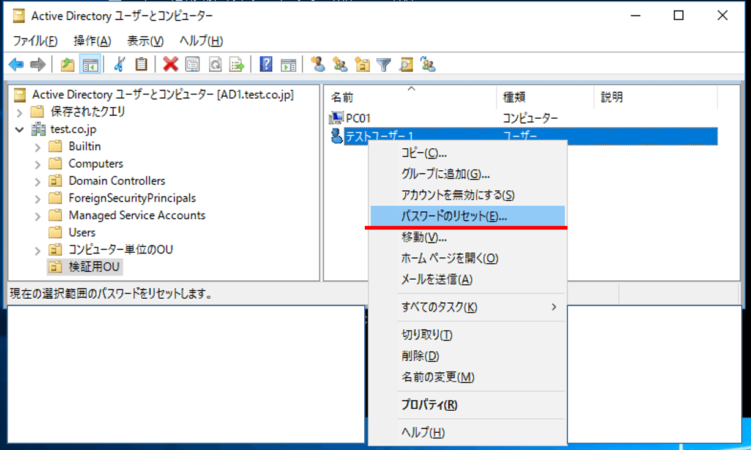

- Change mac password active directory how to#
- Change mac password active directory mac os#
- Change mac password active directory windows#
"0" tells the system that the " Password age" function is disabled. In the window that opens, set the value " Password age" to 0 or the value you need. In the right side block "Maximum password age is 42 days" In this editor, in the left side block, open the tree: "Computer Configuration" -> "Policies" -> "Windows Settings" -> "Security Settings" -> "Account Policies" -> "Password Policy". The "Group Policy Management Editor" will open. In the "Account Policy / Password Policy" list, right-click on "Maximum Password Age 42 Days" and select "Edit" in the context menu. In the "Settings" tab, open the following tabs: "Policies" -> "Windows Settings" -> "Security Settings" -> "Account Policies / Password Policy": The "Group Policy Management" window will open. In the left side block open the tree: "Forest: Your Domain Name" -> "Domains" -> "Your Domain Name" -> "Default Domain Policy" then select the "Settings" tab in the right side block. I am trying to change password for my own account in AD using powershell.My account is just a regular account (no domain admin rights) I tried net user, dsquery and powershell cmdlets, but all of them errors out 'Access is denied'. Open "Start" -> "Administrative Tools" -> "Group Policy Management" On the server, the "Password age" function is set to 42 days by default which means that every 42 days your system will require a password change. Where to change or disable this feature is discussed below. Press " OK". If all the data have been entered correctly, a window will appear confirming successful password change. Let's proceed to the "Password age" function. Unblock the relevant user account if the user has been locked by the system. Check the box "User must change password at the next logon" if required.ģ.

Enter a new password (password must be at least 8 characters)Ģ. The list of users will emerge on the left side select one of the users by name and right click on "Reset Password. In the new window that appears, open the section containing the name of your domain – in the screenshot this is "" – and click on the "Users" folder. For this purpose, open "Start" -> "Administrative Tools" -> "Active Directory Users and Computers"
Change mac password active directory how to#
This manual describes how to change a password for a server with Active Directory domain service. Click OK and, after a few seconds, you should be done.
Change mac password active directory windows#
Active Directory logins should work, and create their own home directory automatically.Changing user password in Windows Server 2012 with Active Directory Changing an AD password Next, click the Bind button and enter in your Active Directory username and password. Click OK again, quit Directory Utility, and reboot the Mac. Next, click the Bind button and enter in your Active Directory username and password. Enable the Allow Administration By option this will make anyone in the enterprise or domain admins group a local administrator on that Mac. The only other change I’d make is in the Administrative tab. That will make using Active Directory logins much easier.

The only change you’ll want to make in this tab is to enable Create Mobile Account at Login.
Change mac password active directory mac os#
While Windows Server 2003 was the last version of Windows Server to support Services For Macintosh, it was one of the worst AFP servers ever you’re better off using Mac OS X’s SMB support than Windows’ AFP support. In particular, leave Network Protocol To Be Used set to smb. In the user experience tab, you can probably leave most of the the defaults. Most administrators usually change (reset) AD user. The option User must change password at next logon is usually enabled when creating a new Active Directory user, when the administrator resets the user’s password (when the user forgot his password or the password was compromised). Leave the computer ID alone Directory Utility pulls that from the Sharing preferences. In this article we’ll consider how to change (or reset) a users’ Active Directory passwords using the PowerShell cmdlet Set-ADAccountPassword. (That’s for far larger networks.) Obviously enough, you’ll want to enter your Active Directory domain name in the Active Directory Domain field. Once you are back to the Login screen click Cancel to go back to your Desktop. Type your current AD password in the Old password box, type your new password in the New password box and Confirm password box. When you double-click on Active Directory, you’ll get a sheet that looks like this:įor your purposes, you can ignore the Active Directory Forest field. The Login screen opens, select Change a password button to change your AD password. (You’ll probably have to authenticate.) There, you’ll see a list of services in the main Directory Utility window. Go to /System/Library/CoreServices and open Directory Utility. You also want to make sure that you have rights in Active Directory to add computers to that container.


 0 kommentar(er)
0 kommentar(er)
